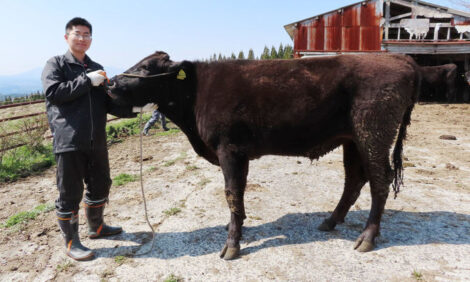



Weekly global protein digest: First outbreak of FMD in Germany since 1988
Livestock analyst Jim Wyckoff reports on the global protein marketWeekly USDA US beef, pork export sales
Beef: Net sales of 13,100 MT for 2025 primarily for South Korea (7,400 MT, including decreases of 400 MT), Japan (2,700 MT, including decreases of 300 MT), Mexico (1,000 MT, including decreases of 100 MT), Canada (500 MT, including decreases of 100 MT), and Taiwan (400 MT, including decreases of 100 MT), were offset by reductions for China (500 MT). Exports of 14,900 MT were primarily to South Korea (4,800 MT), Japan (3,600 MT), China (2,200 MT), Mexico (1,300 MT), and Canada (800 MT).
Pork: Net sales of 24,900 MT for 2025 were primarily for Japan (6,200 MT), Mexico (5,000 MT, including decreases of 200 MT), South Korea (3,600 MT, including decreases of 200 MT), the Dominican Republic (2,300 MT), and Colombia (2,200 MT, including decreases of 100 MT). Exports of 31,000 MT were primarily to Mexico (12,000 MT), South Korea (4,000 MT), Japan (3,900 MT), China (3,200 MT), and Colombia (1,700 MT).
US egg prices hit record high
The latest monthly consumer price index showed that the average price of a dozen Grade A eggs in the U.S. reached $4.95 in January, eclipsing the previous record of $4.82 set two years earlier and more than double the low of $2.04 in August 2023, the Associated Press reported. Relief is not expected anytime soon, as highly pathogenic avian influenza (HPAI) cases continue to hit layer flocks and the peak demand season around Easter is ahead.
USDA monthly report on US livestock, dairy
LIVESTOCK, POULTRY, AND DAIRY: Red meat, poultry, and egg supply and use estimates for 2024 are adjusted to reflect December production, ending stock, and trade data. For 2025, the beef production forecast is raised from last month. On February 1, 2025, the Animal and Plant Health Inspection Service (APHIS) announced the resumption of cattle imports from Mexico through approved facilities and newly implemented protocols to mitigate the spread of New World Screwworm.
Additionally, the USDA’s January Cattle report estimated a larger calf crop for 2024 and a smaller decline in cattle outside feedlots than previously expected. As a result, higher placements are expected for the year and slaughter is raised, primarily in the second half of the year. Dressed weights are also raised. Pork production is raised as higher weights throughout the year more than offset the slower rate of slaughter expected in the first quarter. Broiler production is unchanged, with an expected slower rate of slaughter in the first quarter, in part due to Highly Pathogenic Avian Influenza (HPAI)-related culling, offset by increased production in the third quarter.
Turkey production is also lowered on HPAI-related culling and the latest hatchery data. Egg production is reduced in every quarter of 2025 due to HPAI-related culling reported through early February, as the flock is expected to steadily rebuild, particularly in the second half of the year. Beef exports for 2025 are raised on the increase in production and continued strong global beef demand. Beef imports are unchanged. Pork exports are lowered for the second half of the year on slower-than-previously-expected growth in several key export markets. The broiler export forecast is lowered on recent trade data and increased global export competition. The turkey export forecast is lowered on reduced domestic supplies.
For 2025, cattle prices are raised for all four quarters on recent prices and continued strong beef demand. Hog prices are raised for the first quarter on recent prices. The 2025 broiler price forecast is unchanged, as a lower forecast for the first quarter based on recent prices is offset by raised price expectations for the second half of the year. The turkey price forecast is lowered on recent prices and continued weakness in demand.
Egg prices are raised for all four quarters, as the flock recovers from the HPAI-related reductions reported through early February. Milk supply and use estimates for 2024 are adjusted to reflect December domestic and trade data. WASDE-657-4 For 2025, milk production is reduced due to lower expected cow inventories. On a fat basis, domestic use is lowered as less production and lower imports tighten supplies. Fat basis exports are lowered, as higher butter exports are more than offset by lower fluid and dry milk and cream products. Skim-solids basis domestic use is also lowered based on the tighter production outlook.
Skim-solids basis exports are lowered on decreased exports of nonfat dry milk (NDM) and whey. Milk and dairy product price forecasts reflect the updated price formulas of the Federal Milk Marketing Order, as published in the Federal Register on January 17, 2025 by the Agricultural Marketing Service. Butter, NDM, and whey prices for 2025 are all lowered based on recent prices. The cheese price is raised on recent prices and tight inventories from 2024 that are expected to carry into 2025. Class III and Class IV prices in 2025 are lowered. The all milk price estimate for 2024 is raised to $22.61 per cwt based on reported data through December. The all milk price forecast for 2025 is lowered to $22.60 per cwt.
Global food price index declines in January
The UN Food and Agriculture Organization global food price index declined 1.6% in January, as decreases in prices of sugar, vegoils and meat more than offset increases in those for dairy products and cereal grains. Compared to year-ago, prices rose 8.1% for meat, 20.4% for dairy and 24.9% for vegoils, while values fell 6.8% for cereal grains and 18.5% for sugar.
US pork exports finish 2024 on a strong note
The US exported 645.8 million lbs. of pork during December, the second most for the month behind 2019 and the highest monthly tally since April 2024. For 2024, pork shipments totaled 7.115 billion lbs., up 291.3 million lbs. (4.3%) from the previous year, fueled by a 3.7% increase to top buyer Mexico and a 12.0% jump to South Korea. Beef exports totaled 258.9 million lbs. in December. In 2024, beef shipments reached 3.003 billion lbs., down 34.9 million lbs. (1.1%) from the previous year as reduced exports to South Korea, China and Canada more than offset increases to Japan, Mexico and Taiwan.
Germany: First outbreak of Foot-and-Mouth-Disease in Germany since 1988
On January 10, 2025, the German Federal Research Institute for Animal Health (FLI) confirmed a Foot-and-Mouth Disease (FMD) case on a water buffalo farm in Brandenburg. As a result, Germany lost its recognition as “free from foot-and-mouth disease without vaccination” by the World Organization for Animal Health. FMD can result in significant economic losses due to the closure of foreign export markets, and costs associated with containing the disease. Several countries (e.g., Canada, Mexico, South Korea, US, UK) have already put import restrictions in place.
New HPAI strain found in Nevada dairy cattle
USDA’s Animal and Plant Health Inspection Service (APHIS) confirmed the first detection of highly pathogenic avian influenza (HPAI) H5N1 clade 2.3.4.4b, genotype D1.1 in dairy cattle in Nevada. This discovery follows state investigations and testing under the National Milk Testing Strategy (NMTS). The genotype, which has been prevalent in North American wild birds, mammals, and poultry, is now identified in dairy cattle for the first time. Four cases were confirmed on Jan. 31, prompting quarantine measures in Nye and Churchill Counties. APHIS is conducting further investigations and will release a technical brief on the findings in the coming week.
Weekly USDA dairy report
CME GROUP CASH MARKETS (2/7) BUTTER: Grade AA closed at $2.3800. The weekly average for Grade AA is $2.4100 (-0.0645). CHEESE: Barrels closed at $1.7800 and 40# blocks at $1.8600. The weekly average for barrels is $1.7970 (-0.0520) and blocks $1.8685 (-0.0320). NONFAT DRY MILK: Grade A closed at $1.3300. The weekly average for Grade A is $1.3380 (-0.0080). DRY WHEY: Extra grade dry whey closed at $0.5875. The weekly average for dry whey is $0.6055 (-0.0715).
BUTTER HIGHLIGHTS: Butter demand varies from lighter to steady. Cream volumes are plentiful and affordable. Cream multiples under 1.00 continued to be conveyed from stakeholders. The West region had the lowest bottom end All-Classes cream multiple, which was 0.75. Butter production schedules vary from steady to strong. More than ample volumes of affordable cream are being worked through churns to build stock for spring demand needs. Both salted and unsalted loads are available. Bulk butter overages range from 5 cents below to 6 cents above market, across all regions.
CHEESE HIGHLIGHTS: Cheese production schedules are mixed throughout the U.S. In the East region, cheesemakers relay steady to stronger production schedules. Milk remains snug but available for Class III processing. Cheese inventories are generally available for interested buyers. In the Central region, contacts share cheese demand is strong for most varieties. Some barrel suppliers relay demand has quieted somewhat but remains elevated. Milk availability is mostly balanced with spot milk prices ranging from $1 under to $2 over Class III. In the West region, cheesemakers relay variable production schedules due to snug spot milk availability. Some contacts note cheese inventories are tight while others say they are available for interested spot purchasers.
FLUID MILK HIGHLIGHTS: Winter temperatures are chilling fluid milk production over parts of the country. Stronger volumes in the Central and East regions have cooled down to steady production numbers. Producers in Idaho and the Pacific Northwest are also experiencing less than strong volumes. Contacts say cooler temperatures and precipitation are influencing cow comfort. Farms in the remainder of the West continue to report strengthening milk volumes. Bottlers, nationwide, continue to take on steady amounts of milk. Demand from Class I has remained strong well into February while demand from other Classes is somewhat mixed. That said, Central spot milk prices, which ranged from $1-under to $2-over this week, are somewhat in line with prices during week six in 2024: $0.00 to $1-over Class III. Condensed skim milk demand is mixed. Buyers are showing increased interest in the East and in pockets of the West. Contacts report that spot loads of condensed skim are available in the West and are tightening in the East. Contacts tell a different story when it comes to cream. Contacts across the country echo that cream is easily acquired, and this is expected be the case into Spring of 2025. Processors in the East report loads of cream are lined up for churns. Some suppliers in the Central region mention that more loads are having to travel further to find end users. Contacts report cream multiples moved lower this week. Cream multiples for all Classes range 0.90-1.16 in the East, 0.85-1.20 in the Midwest, and 0.75 1.10 in the West.
DRY PRODUCTS HIGHLIGHTS: Low/medium heat nonfat dry milk (NDM) prices slipped in all regions on slower domestic and quiet export demand. Dry buttermilk prices followed suit, and decreased as buyers are cautious about adding to their inventories. Dry whey prices decreased markedly on bearish market tones signaled by growths in availability and a hesitant customer base. Lactose prices were steady to higher on quiet trading outside of contractual agreements. Whey protein concentrate 34% prices were mixed, but more bullish than bearish as market tones remain intact despite other dairy powder markets meeting notable bearish pressure this week. Dry whole milk prices slipped on quieted demand tones. Acid casein prices slipped, while rennet casein prices were unchanged.
ORGANIC DAIRY MARKET NEWS: The Foreign Agricultural Service (FAS) releases monthly export data which includes export volumes and values for organic milk categorized as HS-10 code 0401201000. Recently released data for December 2024 indicated organic milk exports were 396,773 liters, down 21.1 percent from the month prior, but up 105.8 percent from 2023. Exports of organic milk from the start of the year through December are up 54.4 percent, compared to the same time period one year ago.
NATIONAL RETAIL REPORT: Dairy advertisement totals diverged between conventional and organic dairy items this week. Conventional ad totals increased 18 percent, while organic ad numbers decreased by 12 percent. The most advertised item this week is conventional ice cream in 48-to-64-ounce containers, while half-gallon milk is the most advertised organic dairy item. As a commodity, conventional cream cheese ad totals more than tripled this week, and organic cream cheese ad totals moved four percent higher.



